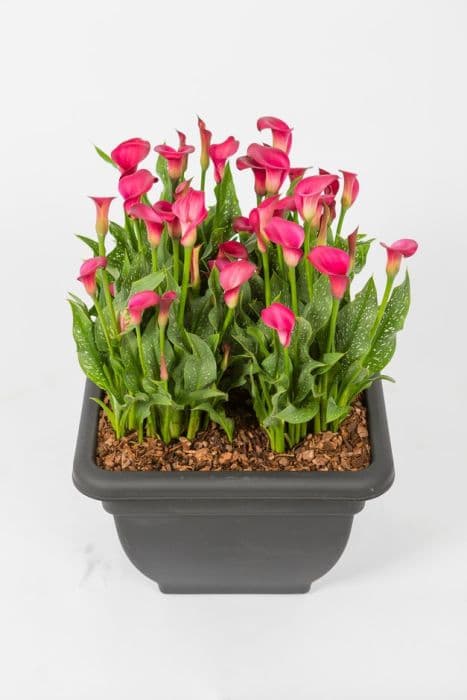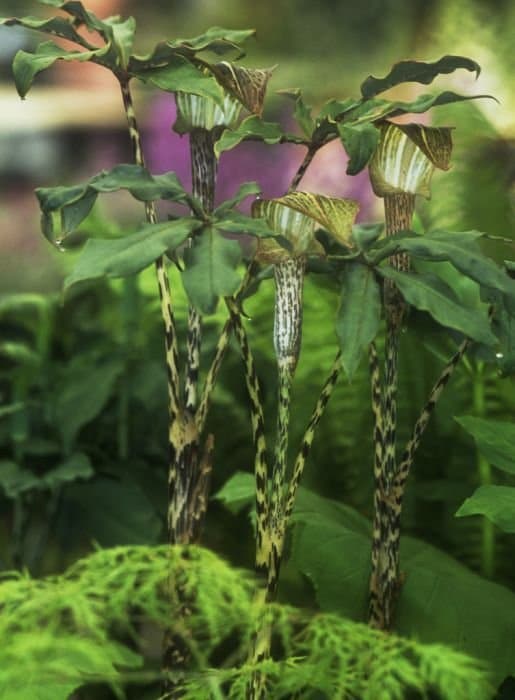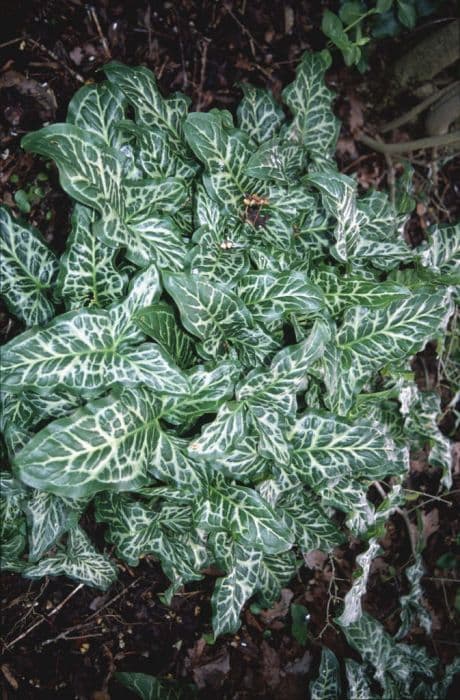Calla Lily 'Flirt' Zantedeschia 'Flirt' (PBR)

ABOUT
The Zantedeschia 'Flirt' (PBR), commonly known as the calla lily 'Flirt', is a graceful and elegant plant that showcases striking trumpet-shaped flowers. These blooms typically come in a palette of vivid colors, depending on the variety, but the 'Flirt' carries a particular hue that's both unique and eye-catching. The flowers possess a waxy texture and emerge from a spathe, which is a type of bract, or modified leaf, that curves gracefully around the central spadix, a spike where the tiny true flowers are located. The foliage of the calla lily 'Flirt' is equally beautiful, with a rich, glossy green color and a smooth, sometimes speckled texture. Leaves are often broad and arrow-shaped, providing a lush, verdant backdrop for the dramatic blooms. The plant exudes an overall sense of sophistication and simplicity, evoking the feeling of a classic yet contemporary design. The appearance of Zantedeschia 'Flirt' makes it a popular choice for cut flowers, as well as for decoration in gardens and patios where its showy flowers can add a splash of brilliance.
About this plant
 Names
NamesFamily
Araceae
Synonyms
Calla Lily, Arum Lily.
Common names
Zantedeschia 'Flirt' (PBR)
 Toxicity
ToxicityTo humans
The Zantedeschia 'Flirt' (PBR) is commonly known as a Calla Lily. This plant is toxic to humans if any part is ingested. The toxins include compounds such as calcium oxalate crystals, which can cause irritation to the mouth and gastrointestinal tract. Symptoms of poisoning may include a burning sensation in the mouth, swelling of the lips, tongue, and throat, difficulty swallowing, and nausea. In severe cases, vomiting and diarrhea may also occur. It is essential to keep this plant away from children who might be tempted to chew on it.
To pets
The Zantedeschia 'Flirt' (PBR), commonly called Calla Lily, is toxic to pets. Ingestion of any part of the plant can lead to symptoms such as oral irritation, intense burning and irritation of the mouth, lips, and tongue, excessive drooling, vomiting, and difficulty swallowing. In severe cases, ingestion can cause dehydration and possibly more severe symptoms, depending on the amount ingested. Immediate veterinary attention is recommended if a pet has consumed any part of a Calla Lily plant.
 Characteristics
CharacteristicsLife cycle
Perennials
Foliage type
Evergreen
Color of leaves
Green
Flower color
Pink
Height
1-2 feet (30-60 cm)
Spread
1 foot (30 cm)
Plant type
Herb
Hardiness zones
9
Native area
Africa
Benefits
 General Benefits
General Benefits- Aesthetic Appeal: Calla Lily 'Flirt' features elegant, trumpet-shaped flowers that can enhance the beauty of gardens and indoor spaces.
- Versatility: It is suitable for planting in flower beds, borders, containers, and also makes a striking cut flower for arrangements.
- Easy to Grow: This variety is known to be low maintenance and can thrive with minimal care, making it a good option for novice gardeners.
- Long Blooming Season: Calla Lily 'Flirt' offers a longer blooming season compared to some other garden plants, providing continuous color and interest.
- Attracts Pollinators: The flowers can attract beneficial pollinators like bees and butterflies to the garden, supporting local ecosystems.
- Drought Tolerance: Once established, it has a good level of drought resistance, reducing the need for frequent watering.
- Compact Growth: Calla Lily 'Flirt' has a compact growth habit, making it ideal for smaller spaces or urban gardens.
 Medical Properties
Medical PropertiesThis plant is not used for medical purposes.
 Air-purifying Qualities
Air-purifying QualitiesThis plant is not specifically known for air purifying qualities.
 Other Uses
Other Uses- Creative Photography Subject: The Zantedeschia 'Flirt' provides a stunning visual with its unique shape and colors, making it a popular choice for photographers looking for a floral subject with a twist.
- Edible Flowers (with Caution): Although not commonly known for its edibility and needing careful preparation to remove toxins, the flowers can surprisingly be used to garnish salads or desserts after ensuring all parts are non-toxic.
- Art Inspiration: The striking appearance of the calla lily inspires artists to create paintings, drawings, and even sculptures, capturing its elegant form and colorful spathe.
- Biodegradable Confetti: Dried petals of the Zantedeschia 'Flirt' can be used as a natural and biodegradable confetti for outdoor celebrations, reducing environmental impact.
- Educational Resource: Botany students can study Zantedeschia 'Flirt' to learn about unique plant structures, hybridization, and the adaptation of plants to their environments.
- Theme Garden Component: The calla lily's distinctive look can be used to create themed gardens, like a "black and white" garden, providing a dramatic visual contrast with its darkly shaded spathe.
- Natural Ink Source: The pigments in the spathe could be used as a natural colorant for making inks for art or craft projects, although commercial preparations and testing would be necessary.
- Fashion Design Inspiration: The sleek lines and curves of Zantedeschia 'Flirt' are often mirrored in fashion design, from textile patterns to the silhouettes of haute couture.
- Jewelry Molding: The unique form of the calla lily can serve as a mold or inspiration for creating intricate jewelry designs in metals or other materials.
- Dye for Fabrics: While not a common use, the pigments could potentially be extracted and used to naturally dye textiles, though consistency and colorfastness may vary.
Interesting Facts
 Feng Shui
Feng ShuiThe Calla Lily is not used in Feng Shui practice.
 Zodiac Sign Compitability
Zodiac Sign CompitabilityThe Calla Lily is not used in astrology practice.
 Plant Symbolism
Plant Symbolism- Purity: Often associated with the color white, calla lilies (the most common common name for Zantedeschia) are commonly linked to purity, making them popular in bridal bouquets and religious ceremonies.
- Beauty: Calla lilies have an elegant form and are frequently admired for their striking beauty, often symbolizing exceptional beauty in the language of flowers.
- Faith and Devotion: Because of their use in religious events and their serene appearance, calla lilies can represent faithfulness and a commitment to something or someone.
- Rebirth and Resurrection: Their trumpet-shaped blooms are reminiscent of trumpets commonly depicted in Christian iconography, symbolizing triumph and new beginnings such as resurrection.
 Water
WaterCalla Lily 'Flirt' requires consistent moisture, especially during the growing and blooming season. Water the plant thoroughly once the top inch of the soil feels dry to the touch. On average, this could mean watering approximately once a week, but always check the soil moisture level first. Use about half a gallon of water for a medium-sized pot, ensuring that the water drains freely and does not leave the soil waterlogged. During dormancy in the cooler months, reduce watering frequency to prevent rot.
 Light
LightCalla Lily 'Flirt' thrives in bright, indirect sunlight. A spot near a window that gets plenty of light but is shielded from the direct harsh rays of the sun is ideal. Avoid placing the plant in full shade or direct sunlight, as too little light can lead to weak growth, while too much can scorch the leaves.
 Temperature
TemperatureCalla Lily 'Flirt' prefers temperatures between 60 to 75 degrees Fahrenheit for optimal growth. It can tolerate a low temperature of about 50 degrees Fahrenheit but should not be exposed to temperatures below this as it may damage the plant. Always keep the plant away from drafts and sudden temperature changes for the best health.
 Pruning
PruningCalla Lily 'Flirt' requires minimal pruning, mainly to remove spent blooms and yellowing leaves. Pruning can encourage new growth and keep the plant looking tidy. The best time to prune is immediately after the blooms have faded, which can vary depending on your climate and the plant's environment. Generally, pruning can be done every few weeks during the active growth season.
 Cleaning
CleaningAs needed
 Soil
SoilCalla Lilies, such as Zantedeschia 'Flirt', thrive in well-draining, rich potting mix with a slightly acidic to neutral pH of 5.5 to 7.0. A mix of two parts peat moss or coco coir, one part perlite, and one part compost or well-rotted manure creates an ideal growing medium.
 Repotting
RepottingCalla Lilies, like Zantedeschia 'Flirt', should be repotted every one to two years to refresh the soil. The best time to repot is after the blooming season or during early spring.
 Humidity & Misting
Humidity & MistingCalla Lilies prefer moderate to high humidity levels; aim for a humidity level between 50% and 70% for optimal growth of Zantedeschia 'Flirt'.
 Suitable locations
Suitable locationsIndoor
Place Calla Lily 'Flirt' in bright, indirect light with moderate watering.
Outdoor
Keep Calla Lily 'Flirt' in partial shade, water regularly, and protect from frost.
Hardiness zone
8-11 USDA
 Life cycle
Life cycleThe Zantedeschia 'Flirt', commonly known as the Miniature Calla Lily, begins its life cycle as a rhizome planted in well-drained soil during late winter or early spring. As temperatures warm, it sprouts and develops lush, arrow-shaped foliage, followed by the signature miniature calla flowers in late spring to early summer. After blooming, the plant spends summer accumulating and storing energy in its rhizome for the next season. Once the flowering ceases and leaves begin to yellow in late summer to autumn, the plant enters a dormant period where watering should be reduced considerably. During winter dormancy, the rhizome can either be left in the ground in warmer climates or lifted and stored in colder regions to protect it from frost. The following spring, the cycle begins anew when the stored rhizome is replanted or naturally re-sprouts, continuing the perennial life cycle of the Miniature Calla Lily.
 Propogation
PropogationPropogation time
Spring-Early Summer
The Zantedeschia 'Flirt', commonly known as Calla Lily 'Flirt', is often propagated by division of its rhizomes. The most favorable time to do this is in the late winter to early spring when the plant is dormant, which helps to minimize stress and encourages a better chance of successful rooting. To propagate by division, carefully lift the rhizomes from the soil and brush off any excess dirt. Using a clean, sharp knife, make sure to divide the sections so that each has at least one growth eye or bud. These sectioned rhizomes should then be allowed to dry for a day to form a callous over the cuts, which can help prevent rotting when planted. Afterward, they can be replanted into well-draining soil at a depth of approximately 4 inches (10 centimeters) and spaced roughly 12 inches (30 centimeters) apart to allow for growth and adequate air circulation around the new plants. With the proper care and conditions, the new Calla Lily 'Flirt' plants will establish themselves and start their growth cycle, leading to blooming in the following season.









